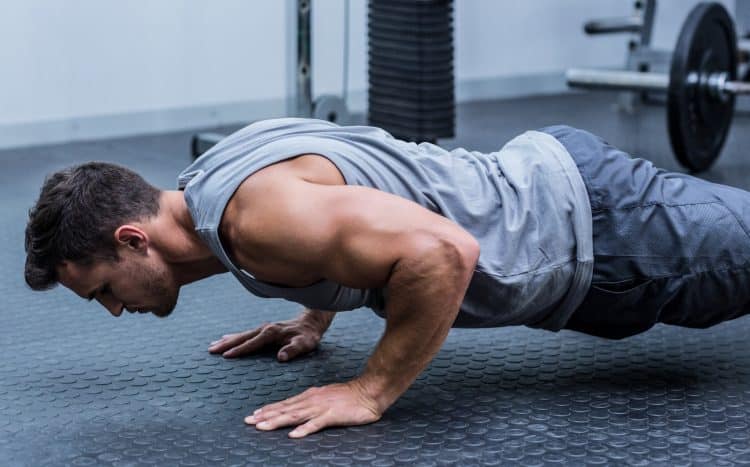Jacked arms have long been a symbol of strength and masculinity. It is no surprise that building bigger arms is one of the most popular bodybuilding goals, especially among men.
However, most people have to live with puny arms because they don’t have access to strength training equipment.
Dumbbells and barbells are a luxury when it comes to building bigger pythons, not a necessity.
As a personal trainer with over 17 years in the industry, I have helped hundreds of people build sleeve-ripping biceps with bodyweight exercises. In this article, I pull back the curtain on my secrets, including the six exercises and how to program them for maximum effectiveness.
6 Essential Bodyweight Exercises for Building Bigger Biceps
Here are six exercises that should be a part of your arsenal:
Level Up Your Fitness: Join our 💪 strong community in Fitness Volt Newsletter. Get daily inspiration, expert-backed workouts, nutrition tips, the latest in strength sports, and the support you need to reach your goals. Subscribe for free!
1. Isometric Contractions and Dynamic Contractions
| Difficulty | Beginner |
| Progression | Increase duration of isometric holds, add resistance to dynamic contractions |
| Regression | Limited ROM |
If you were to ask me about the most underrated training technique, especially for home trainers, I would say isometric contractions. It involves holding your muscles in the fully shortened position and contracting them as hard as possible.
Bodybuilding legend Charles Atlas (1892-1972) took isometric contractions one step further and developed ‘dynamic tension’ for building muscle mass without using additional resistance. During dynamic tension, you must focus on flexing the target muscle as hard as possible throughout its entire ROM. Then, return to the starting position, mimicking a negative rep.
How To Do Bicep Curl Dynamic Contractions:
- Stand upright with a hip-width stance with your arms extended at your sides.
- Keep your elbows pinned to your sides, and slowly flex your elbows while contracting the target muscles as hard as possible.
- Imagine as if you’re fighting resistance during the concentric phase.
- Slowly return to the starting position as if you are lowering a super heavyweight.
Coach Tip: Time under tension (TUT) is key when using this training technique. Take as long as possible during the eccentric and concentric phases to maximize muscle growth. (1)
2. Chin-Up
| Difficulty | Advanced |
| Progression | Weighted chin-ups, one-arm chin-ups |
| Regression | Assisted chin-ups (resistance band or machine), negative chin-ups, Australian pull-ups |
This is my go-to exercise to help people build bigger guns without lifting additional resistance. Although this is a bodyweight exercise, even the advanced exercisers have a hard time completing 10 reps of chin-ups with a picture-perfect form. This probably tells you about the potency of this exercise.
Although many people use ‘chin-ups’ and ‘pull-ups’ interchangeably, they are distinct exercises that bias different muscle groups. While the former involves a supinated grip, the latter uses an overhand grip.
How To:
- Position an elevated surface like a stool under a pull-up bar and stand on it.
- Grab the bar with a shoulder-wide underhand grip.
- Step off the stool with your elbows fully extended.
- Flex your elbows to lift your torso toward the ceiling.
- Pause and contract your biceps when your chin is above the bar. Avoid swinging your legs to generate momentum, as it results in secondary muscle engagement.
- Slowly return to the starting position.
Coach Tip: Vary your grip to target the biceps from different angles. Use a narrower grip to target the long bicep head and a wider grip to target the short head.
3. Table Curl
| Difficulty | Beginner |
| Progression | Preacher curls, concentration curls |
| Regression | Isometric bicep holds |
You don’t always have to hit the gym to get a good workout in. Getting creative and making use of things around you can help build guns that would make Arnold Schwarzenegger proud. Given below is one such example:
How To:
- Stand upright, facing a dining table.
- Place your palms under the table’s top with your fingers spread out.
- Maintaining a steady torso, flex your elbows until your lower arms are parallel to the floor.
- Pause and contract your biceps as hard as possible.
- Return to the bottom position.
- Repeat for recommended reps.
Coach Tip: You could also perform this exercise using a sofa. However, you will have to deadlift your way into the starting position.
4. Underhand Inverted Row
| Difficulty | Beginner to Intermediate |
| Progression | Feet elevated inverted row, one-arm inverted row |
| Regression | Incline push-ups, wall push-ups |
Inverted rows, also known as Australian chin-ups, are a beginner-friendly variation of conventional chin-ups. It helps build bicep and pulling strength, which can translate to better performance in daily functioning and training.
How To:
- Place two chairs parallel and position a broomstick on top of them. The chairs should be high enough so your torso doesn’t touch the floor during the set.
- Lie supine on the floor with your chest under the broom and grab it with an underhand grip.
- Your belly button should be under the stick in the starting position, and your heels should be the only body part touching the floor.
- Pull your chest to the stick by bending your elbows.
- Contract your biceps throughout the range of motion (ROM).
- Slowly return to the starting position.
Coach Tip: Increasing the incline angle makes the exercise easier, whereas positioning your torso parallel to the floor makes it more challenging. You can also place your feet on an elevated surface for an added challenge.
5. TRX Bicep Curl
| Difficulty | Intermediate |
| Progression | TRX bicep curl with feet elevated, single-arm TRX bicep curl |
| Regression | Resistance band bicep curls, dumbbell bicep curls |
TRX curls are the middle ground between bodyweight chin-ups and inverted rows. Using suspension trainers results in greater core and stabilizer engagement, which can improve your overall functionality and performance.
How To:
- Anchor a suspension trainer to an elevated surface like a pull-up bar.
- Grab the D-handle bars using an underhand grip and walk back until the suspenders are at 45 degrees.
- Now, walk your feet out until your body is in a straight line. Your arms should be fully extended in the starting position.
- Bend your elbows to bring your shoulders toward the handles and pause at peak contraction to maximize bicep fiber stimulation.
- Slowly return to the starting position.
Coach Tip: This exercise is more challenging than it looks. Beginners should initially focus only on performing the concentric or eccentric phase.
6. Resistance Band Bicep Curl
| Difficulty | Beginner |
| Progression | Increase resistance band tension, dumbbell bicep curls, cable curls |
| Regression | Isometric bicep holds |
Resistance band bicep curls are as close as we get to weighted bicep curls. Bands make the exercise more challenging during the concentric phase while taking off tension during the lowering phase.
Level Up Your Fitness: Join our 💪 strong community in Fitness Volt Newsletter. Get daily inspiration, expert-backed workouts, nutrition tips, the latest in strength sports, and the support you need to reach your goals. Subscribe for free!
How To:
- Grab a D-handle in each hand and stand in the center of the resistance band with a shoulder-wide stance.
- While maintaining a tall chest, flex your elbows until they are at shoulder level.
- Pause briefly in the fully shortened position.
- Slowly return to the bottom position.
Coach Tip: If you don’t have access to a resistance band, you could also use a towel for this exercise. Employing a towel will essentially turn this exercise into an isometric contraction, which is excellent for maximizing target muscle fiber recruitment.
Designing Your Bicep-Building Workout Routine
It’s now time to roll up our sleeves and get into the nitty-gritty of building bigger guns with bodyweight exercises. Here’s how to structure your training, depending on your various fitness levels and goals:
1. Warm-Up
Loosening up your joints, tendons, and muscles is non-negotiable, even when you are performing a bodyweight workout. Spend five to 10 minutes before each session performing dynamic stretches to get the blood flowing to the target muscles.
2. Workouts
Here are a few workouts you can choose from:
i) Full-Body:
Full-body workouts are excellent for beginners or people who are short on time. This routine will hit all major muscle groups, and you’ll aim to do two to three sessions each week for maximum muscle stimulation.
Here is a sample workout:
| Exercise | Sets | Reps |
| Chin-Ups | 3 | AMRAP |
| Push-Ups | 3 | AMRAP |
| Squats | 3 | 10-12 |
| Lunges | 3 | 10-12 per leg |
| Plank | Hold | 30-60 seconds |

Remember, this is just a template. Feel free to adjust the sets, reps, and even exercises based on your personal preferences.
ii) Bicep Focus:
Think of this workout as the conventional bicep training session you would do in the gym. It includes a variety of exercises to target the muscles from different angles and ensure overall development. You will aim for four to five exercises per workout. Here is a template:
| Exercise | Sets | Reps |
| Chin-Ups | 3 | AMRAP |
| Underhand Inverted Row | 3 | 10-12 reps |
| TRX Bicep Curl | 3 | 10-12 reps |
| Resistance Band Bicep Curl | 3 | 15-20 reps |
| Table Curl | 3 | 10-12 reps per arm |
Coach Tip: Alter the rep tempo to increase the TUT and make the exercises more challenging.
iii) Circuit Training:
This is a high-intensity interval training (HIIT) workout and involves performing a series of exercises back-to-back with minimal rest. This training approach helps you build muscle and burn calories simultaneously.
Since HIIT workouts are relatively shorter, you can aim to include one to two of these sessions along with your regular programming to maximize muscle gains. Check out this workout:
| Exercise | Reps |
| Chin-Ups | AMRAP |
| Underhand Inverted Row | 10-12 reps |
| TRX Bicep Curl | 10-12 reps |
| Resistance Band Bicep Curl | 15-20 reps |
| Table Curl | 10-12 reps per arm |
- Rest for 1-2 minutes, then repeat the circuit 2-3 more times
Frequency and Duration
Research shows that training a muscle group multiple times during a week can help boost hypertrophy. (2)
Since most individuals can recover quickly from bodyweight workouts, you can train your biceps two to three times weekly. However, ensure that you give the target muscles at least 48 hours of rest before sessions for optimal recovery.
Prioritize proper form and control while performing these exercises and avoid rushing through the reps. Increase the number of sets and reps as you get stronger.
Learn to listen to your body. Stop the workout if something doesn’t feel right. Feel free to take a day off if you feel overly sore or fatigued. Going too hard for an extended period makes you more susceptible to injury.
Conclusion
Bodyweight bicep exercises are incredibly convenient and accessible, allowing you to do them anywhere at any time. These versatile exercises also improve your functional strength, improving your performance in day-to-day functioning.
Beginners should start small, doing two to three of these exercises twice or thrice a week. Increase your training volume and intensity as you gain more experience.
As with everything else in the fitness world, building a chiseled physique requires patience, conviction, and determination. Stick to a regular bodyweight training program for at least 12 weeks, and you’ll be amazed by the results.
If you have any questions about the exercises or programming advice explained in this article or need help implementing them into your routine, post them in the comments below, and I’ll be happy to help!
References:
- Burd NA, Andrews RJ, West DW, et al. Muscle time under tension during resistance exercise stimulates differential muscle protein sub-fractional synthetic responses in men. J Physiol. 2012;590(2):351-362. doi:10.1113/jphysiol.2011.221200
- Schoenfeld, B. J., Ogborn, D., & Krieger, J. W. (2017). Dose-response relationship between weekly resistance training volume and increases in muscle mass: A systematic review and meta-analysis. Journal of Sports Sciences, 35(11), 1073–1082. https://doi.org/10.1080/02640414.2016.1210197









